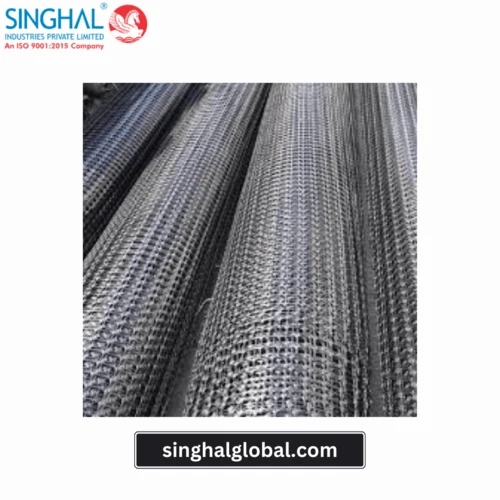The world of civil engineering is constantly evolving, seeking new and innovative solutions to meet the ever-growing demands of infrastructure development. In this quest for progress, biaxial geogrids have emerged as a game-changer, revolutionizing the way we approach ground reinforcement and stabilization.
This article delves into the fascinating world of biaxial geogrids, exploring their properties, applications, and the immense benefits they bring to infrastructure projects. We\'ll unveil key insights about these versatile materials, showcasing their potential to transform the construction landscape.
Understanding Biaxial Geogrids
At their core, biaxial geogrids are polymeric sheets with a robust, open grid-like structure. This structure is formed by intersecting sets of high-strength polymer bars, typically manufactured from polypropylene (PP) or polyester (PET). The bars are welded or bonded together at their junctions, creating a dimensionally stable and high-performance geosynthetic material.
The key characteristic of biaxial geogrids lies in their biaxial nature. Unlike uniaxial geogrids, which offer strength in one primary direction, biaxial geogrids possess equal tensile strength in both their longitudinal and transverse directions. This isotropic property allows them to distribute loads more effectively across the entire geogrid plane, making them ideal for a wider range of applications.
Properties of Biaxial Geogrids
The remarkable performance of biaxial geogrids stems from their unique combination of properties:
1. High Tensile Strength: The robust polymer bars used in their construction provide exceptional tensile strength, enabling them to effectively reinforce soil and other geotechnical materials.
2. Low Elongation: Under stress, biaxial geogrids exhibit minimal elongation, ensuring they maintain their shape and functionality even under heavy loads.
3. Permeability: The open grid structure allows for water drainage, preventing the build-up of hydrostatic pressure and promoting soil stability.
4. Lightweight and Flexible: Biaxial geogrids are easy to transport, handle, and install on-site, owing to their lightweight and flexible nature.
5. Durability: These geogrids are resistant to UV degradation, chemical attack, and biological decomposition, ensuring a long service life.
Applications of Biaxial Geogrids
The versatility of biaxial geogrids translates into a vast array of applications in civil engineering projects. Here are some prominent examples:
1. Reinforcement of Subgrades: Biaxial geogrids are extensively used to reinforce weak subgrades for roads, pavements, and embankments. They improve load distribution, reduce rutting and fatigue cracking, and extend the lifespan of the infrastructure.
2. Retaining Wall Reinforcement: These geogrids play a crucial role in reinforcing retaining walls by providing additional lateral support and preventing soil movement behind the wall.
3. Slope Stabilization: On slopes prone to erosion or landslides, biaxial geogrids are employed to enhance soil stability by anchoring the soil mass and preventing slope failure.
4. Foundation Stabilization: Weak foundations can be significantly strengthened using biaxial geogrids. They help distribute the load from the structure more evenly across the underlying soil, improving foundation stability and preventing settlement.
5. Landfill Construction: In landfill construction, biaxial geogrids are used to improve drainage, enhance the containment of waste materials, and increase the overall stability of the landfill.
Benefits of Using Biaxial Geogrids
The integration of biaxial geogrids into infrastructure projects offers a multitude of benefits:
1. Cost-Effectiveness: By extending the lifespan of infrastructure and reducing maintenance requirements, biaxial geogrids offer significant cost savings in the long run.
2. Improved Construction Efficiency: The lightweight and flexible nature of these geogrids facilitates faster and easier installation, leading to improved construction efficiency.
3. Enhanced Sustainability: By promoting soil stability and reducing erosion, biaxial geogrids contribute to sustainable construction practices.
4. Reduced Environmental Impact: The use of biaxial geogrids often leads to a reduction in the amount of construction materials required, minimizing the environmental impact of the project.
Finding the Right Biaxial Geogrid Suppliers
For successful project implementation, selecting the right biaxial geogrid supplier is crucial. Here\'s a quick guide to finding reputable suppliers in India:
1. Biaxial Geogrid Manufacturers in Ahmedabad: Ahmedabad is a prominent hub for geosynthetic manufacturers in India. A simple Google search for "Biaxial geogrid manufacturers in Ahmedabad" will provide you with a list of potential suppliers.
2. Biaxial Geogrid Manufacturers in Gujarat: Gujarat, as a state, houses several geosynthetic manufacturing companies. You can conduct a web search for "Biaxial geogrid manufacturers in Gujarat" to explore your options.
3. Biaxial Geogrid Exporters Ahmedabad: If you\'re looking for biaxial geogrid exporters based in Ahmedabad, searching for "Biaxial geogrid exporters Ahmedabad" online should yield a list of relevant companies.
When selecting a supplier, consider factors like the manufacturer\'s reputation, product quality certifications, experience in your specific application area, and competitive pricing.
Conclusion
Biaxial geogrids have revolutionized the way we approach infrastructure development. Their remarkable combination of strength, flexibility, and durability makes them a valuable asset for a wide range of civil engineering applications. By leveraging the potential of biaxial geogrids, we can create stronger, more sustainable, and cost-effective infrastructure for the future.
FAQs (Frequently asked questions)
Q1. Do biaxial geogrids require any special installation techniques?
A1. While biaxial geogrids are generally easy to install, following the manufacturer\'s recommended installation procedures is essential. This may involve specific techniques for unfolding, seaming (connecting multiple geogrids), and backfilling with appropriate materials.
Q2. How long do biaxial geogrids last?
A2. Biaxial geogrids, when properly installed and used within their design limitations, can have a design life exceeding 70 years. Their durability is attributed to their high-quality polymer construction and resistance to environmental factors.
Q3. Are there any environmental considerations when using biaxial geogrids?
A3. Biaxial geogrids are generally considered an environmentally friendly product. They can help reduce the need for excavation and construction materials, thereby minimizing environmental impact. Additionally, by promoting soil stability and erosion control, they contribute to sustainable construction practices.



